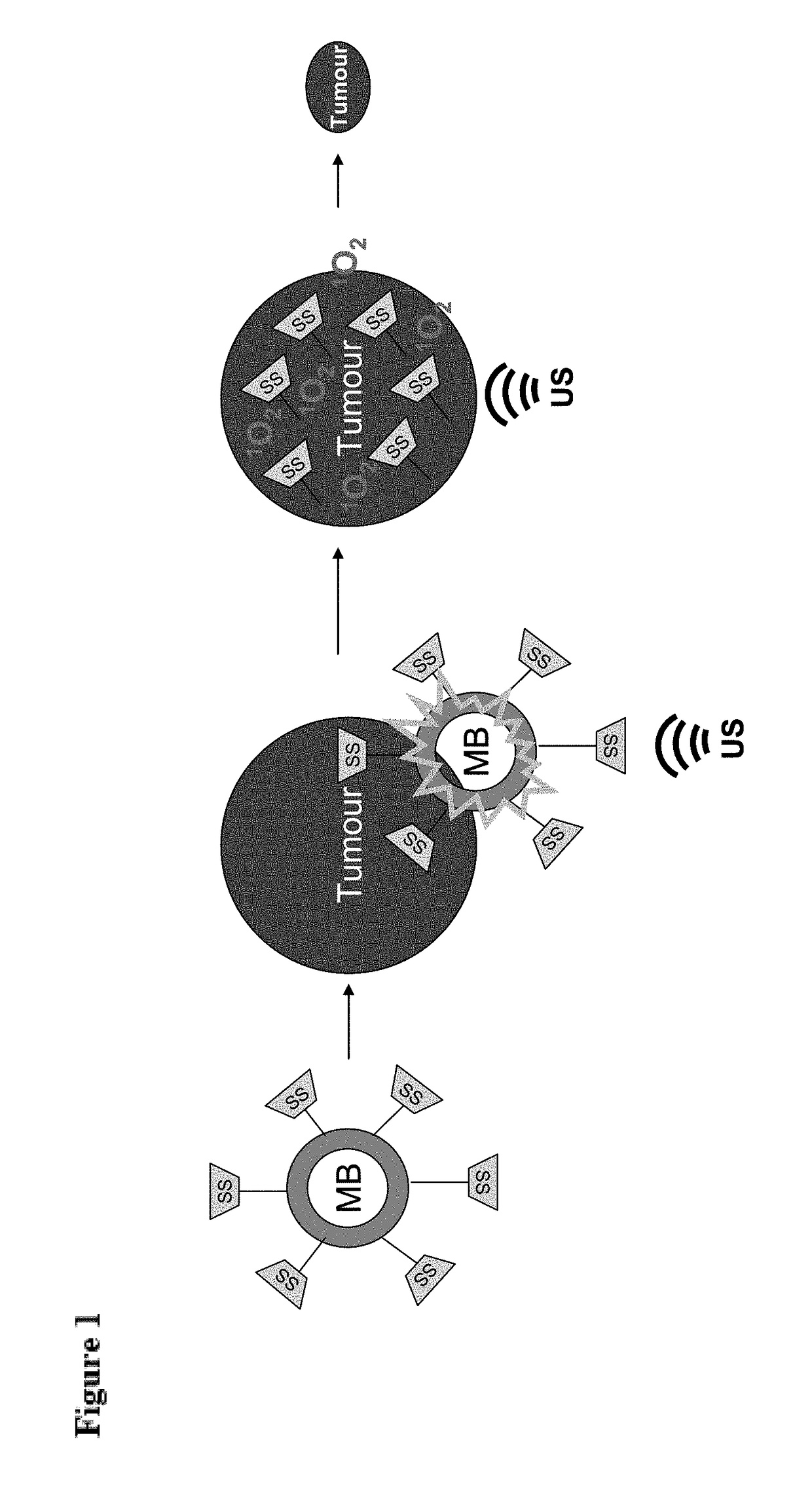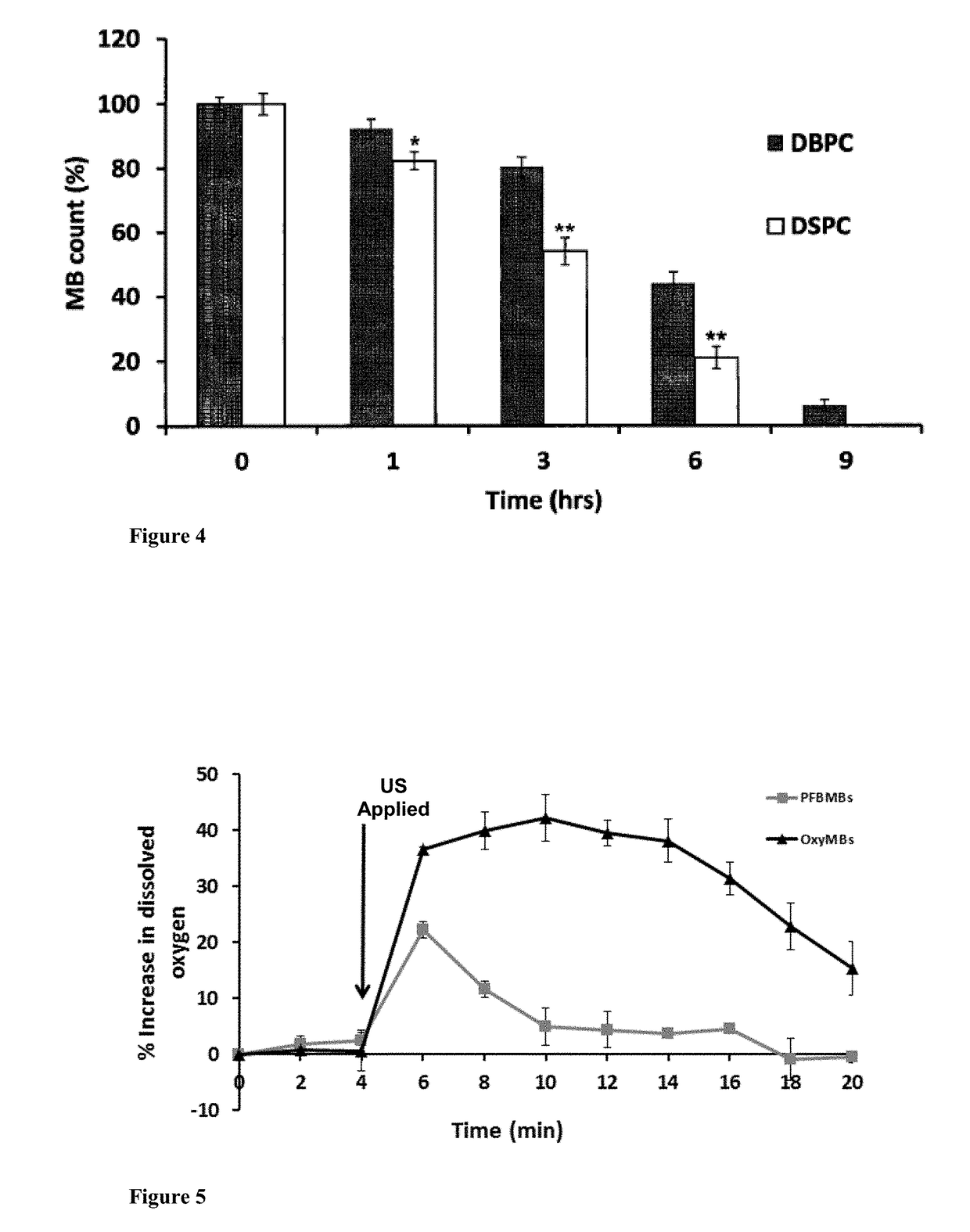Microbubble-chemotherapeutic agent complex for sonodynamic therapy
a technology of sonodynamic therapy and chemotherapeutic agent, which is applied in the direction of capsule delivery, drug composition, disrupted materials, etc., can solve the problems of sepsis, limited penetration of light of this wavelength, and destruction of cells and surrounding vasculature in a target tissue, etc., and achieves significant patient benefit
- Summary
- Abstract
- Description
- Claims
- Application Information
AI Technical Summary
Benefits of technology
Problems solved by technology
Method used
Image
Examples
example 2
on of Biotinylated Rose Bengal and Biotinylated 5-FU
[0131]
[0132]Biotin functionalised Rose Bengal (6) was prepared as described in McEwan et al. (J Control Release. 2015; 203, 51-6). Biotin functionalised 5-FU (5) was synthesized according to scheme 1a following the procedures outlined below.
Preparation N-(2-Hydroxyethyl)-5-(2-oxohexahydro-1H-thieno [3,4-d]imidazol-4-yl)pentanamide (2)
[0133]To an ice-cooled solution of biotin-N-hydroxysuccinimide ester (1) (prepared by the reaction between biotin and Di(N-succinimidyl)carbonate) described in Kang et al., Jr. Rapid Commun Mass Spectrom. 2009, 23(11), 1719-1726) (3.75 g, 11 mmol) in anhydrous DMF (40 mL), was added 2-aminoethanol (1.0 ml, 16.4 mmol) and the mixture stirred at 25° C. for 30 min. The reaction was monitored by thin layer chromatography (TLC) (Merck Silica 60, HF 254, 20:80 methanol-dichloromethane v / v). The biotin-N-hydroxysuccinimide ester (Rf=0.76) was consumed within 15 min with the concomitant formation of the alcoho...
example 6
Cytotoxicity Experiments
[0160]Human primary pancreatic adenocarcinoma cell lines MIA PaCa-2 and PANC-1 were maintained in Dulbecco's Modified Eagle's Medium while BxPC-3 cells were maintained in RPMI-1640 medium, all of which were supplemented with 10% (v / v) foetal bovine serum in a humidified 5% CO2 atmosphere at 37° C. These cell lines were plated into the wells of a 96-well plate at a concentration of 5×103 cells per well and incubated for 21 h at 37° C. in a humidified 5% CO2 atmosphere before being transferred to a hypoxic chamber at 37° C. (O2 / CO2 / N2, 0.1:5:94.9 v / v / v) for 3 h (this is intended to mimic the hypoxic conditions found at a tumor site). The medium was then removed from each well and replaced with O2MB-RB (50 μL, 5 μM RB) and O2MB-5FU (50 μL, 100 μM 5FU) conjugates. Individual wells were then treated with ultrasound delivered using a Sonidel SP100 sonoporator (30 sec, frequency=1 MHz, ultrasound power density=3.0 Wcm−2, duty cycle=50% with pulse repetition frequenc...
example 7
ytotoxicity Experiments
[0162]BxPc-3 cells were maintained in RPMI-1640 medium supplemented with 10% foetal calf serum as described above. Cells (1×106) were re-suspended in 100 μL of Matrigel® and implanted into the rear dorsum of female Balb / c SCID (C.B-17 / IcrHan® Hsd-Prkdcscid) mice. Tumour formation occurred approximately 2 weeks after implantation and tumour measurements were taken every other day using calipers. Once the tumours had reached an average volume of 218 mm3, calculated from the geometric mean diameter using the equation tumour volume=4πR3 / 3, animals were randomly distributed into 10 groups (n=4). Following induction of anaesthesia (intraperitoneal injection of Hypnorm / Hypnovel), a 100 μL mixture of PBS containing O2MB-RB (MB=1.6×107, [RB]=90.8 μM) and O2MB-5FU (MB=5.2×107, [5FU]=440 μM) was injected directly into each tumour. Intratumoural injection was chosen as the route of administration to preclude experimental variation resulting from pharmacokinetic behaviour ...
PUM
| Property | Measurement | Unit |
|---|---|---|
| diameter | aaaaa | aaaaa |
| diameter | aaaaa | aaaaa |
| diameter | aaaaa | aaaaa |
Abstract
Description
Claims
Application Information
 Login to View More
Login to View More - R&D
- Intellectual Property
- Life Sciences
- Materials
- Tech Scout
- Unparalleled Data Quality
- Higher Quality Content
- 60% Fewer Hallucinations
Browse by: Latest US Patents, China's latest patents, Technical Efficacy Thesaurus, Application Domain, Technology Topic, Popular Technical Reports.
© 2025 PatSnap. All rights reserved.Legal|Privacy policy|Modern Slavery Act Transparency Statement|Sitemap|About US| Contact US: help@patsnap.com



